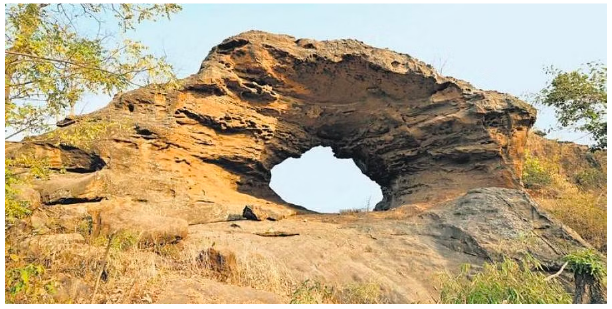Context:
The state unit of Geological Survey of India (GSI) has proposed to declare the ‘Natural Arch’ in Kanika range of Sundargarh forest division a Geo Heritage Site.

Image Source: The New Indian Express
About the Natural Arch:
- Location: Chhengapahar reserve forest near Brahmani village in Kanika range of Sundargarh in Odisha.
- Specifications: Oval-shaped arch
- Time period: 184 to 160 million years in the lower to middle Jurassic age.
- Reasons for Formation: Due to fault activities and nature of lithotype which have enhanced the process of sub-aerial weathering over a long period.
- Significance: The natural arch and its surrounding area is a storehouse of different primary sedimentary structures like planner and cross-bedding along with occasional current ripples signifying high energy fluvial environment during sedimentation.
- Other Arches in India: Tirumala hills in Tirupati and Andaman and Nicobar.
Geoheritage Sites:
- They are the sites containing geo-relics and phenomena, stratigraphic type sections, geological structures and geomorphic landforms including caves, natural rock-sculptures of national and international interest
- They include such portions of land adjoining the site that may be required for their conservation or to access to such sites.
- The GSI declares geo-heritage sites/ national geological monuments for protection and maintenance.
| Additional Information:
About Geological Survey of India (GSI):
- It was set up in 1851 primarily to find coal deposits for the Railway
- Headquarter: Kolkata
- Functions: To creation and updation of national geoscientific information and mineral resource assessment
- Presently, Geological Survey of India is an attached office to the Ministry of Mines.
Jurassic period:
- Jurassic Period is the second of three periods of the Mesozoic Era.
- It extended from 201.3 million to 145 million years ago.
- It was characterised by a warm, wet climate that gave rise to lush vegetation and abundant life. Many new dinosaurs emerged in great numbers.
|
News Source: The New indianExpress
![]() 20 Jun 2023
20 Jun 2023
